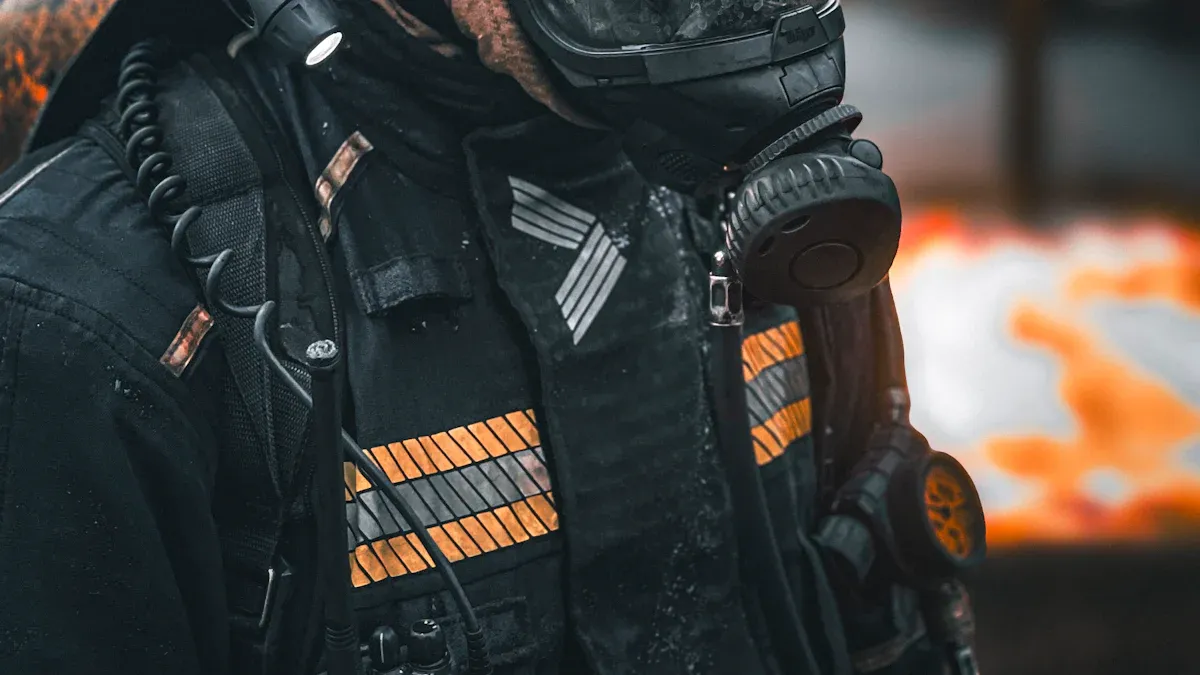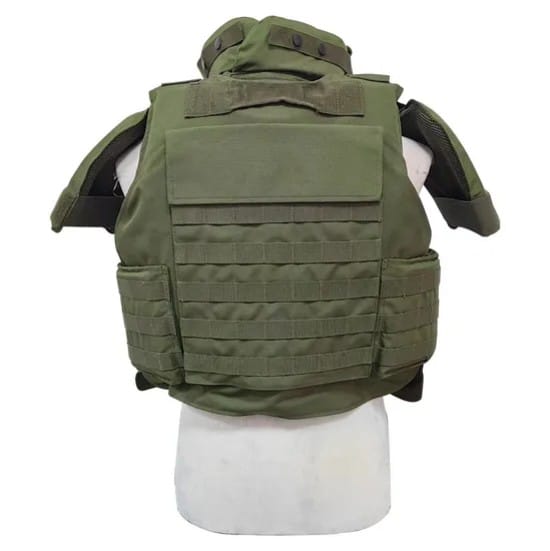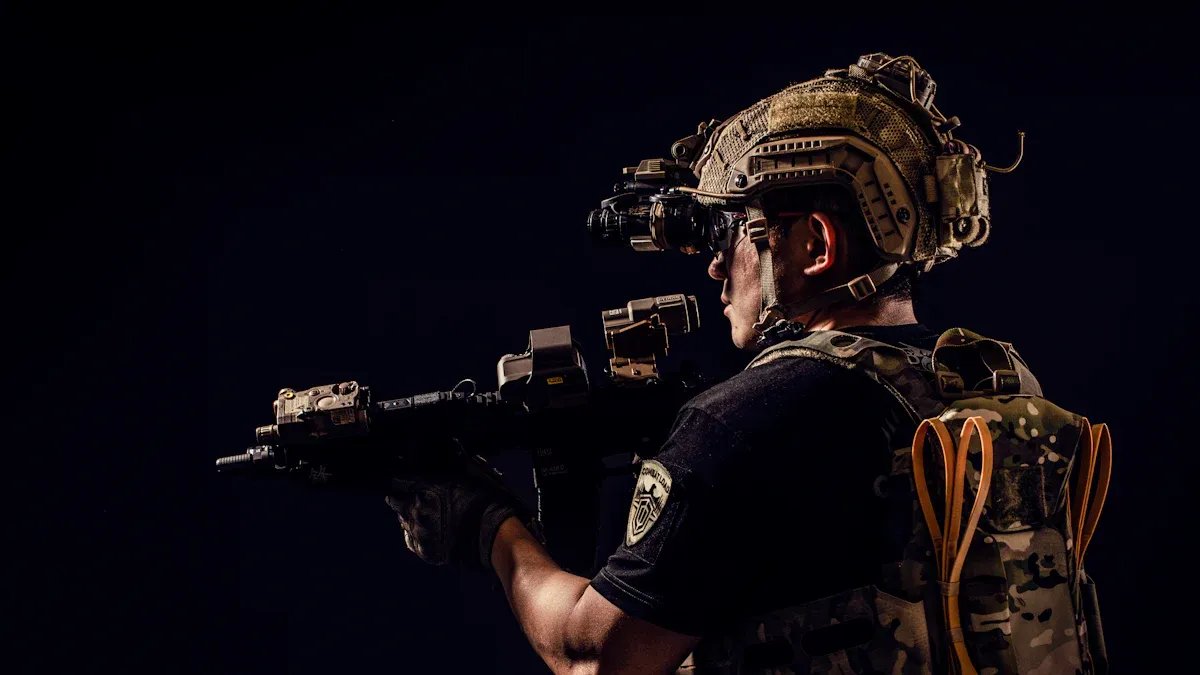
A military bulletproof vest is very important for soldiers. It protects them from bullets, sharp metal pieces, and other dangers in war. These vests work by taking the force of a hit and spreading it out. This lowers the chance of getting badly hurt.
The effect of these vests is clear:
- Soldiers wearing vests are over three times more likely to survive gun attacks than those without vests.
- Only 29% of soldiers shot while wearing vests died, and just one death occurred because the vest failed during the study.
This life-saving gear helps soldiers feel safer and work better in dangerous situations.
Key Takeaways
- Military bulletproof vests help save lives in dangerous situations. Soldiers wearing them are over three times more likely to survive attacks.
- These vests block bullets, sharp metal, and hard hits. They spread out the force of impacts, lowering the chance of bad injuries.
- Picking the right vest is very important. Soft vests are lighter and easier to wear, but hard vests stop stronger bullets.
- New materials like Kevlar and UHMWPE make vests better. They are lighter and more comfortable for long missions.
- Taking care of vests is very important too. Check for damage often and replace them every 5–7 years for the best protection.
How Military Bulletproof Vests Work


Energy Absorption and Dispersion
A military bulletproof vest keeps you safe by spreading energy. When a bullet hits, it slows down as the vest absorbs energy. This spreads the force over a larger area, reducing injuries.
The vest’s materials are strong and flexible. Soft armor uses tightly woven fibers that stretch to absorb energy. Harder materials like UHMWPE layers handle more force during tests. The way fibers are placed and bonded helps stop bullets.
Did you know? These vests also protect against blunt hits. They spread the impact, preventing serious internal injuries even if the bullet doesn’t go through.
Here’s how different materials help absorb energy:
| Material | Energy Absorption Features | Extra Details |
|---|---|---|
| Akzo | Uses tiny fibers to spread energy across nearby threads. | Lightweight and flexible for comfort. |
| Dyneema | Very strong and light; absorbs energy well. | Can hold up to 240 kg with a thin rope. |
| Kevlar Protera | Strong fabric that absorbs energy and stretches under pressure. | Lighter and more flexible due to advanced production methods. |
Hard Armor vs. Soft Armor
Choosing between hard and soft armor depends on your needs. Soft armor is light and easy to wear for long hours. It stops handgun bullets and is commonly used by police. But it can’t stop fast rifle bullets.
Hard armor has tough plates made of ceramic or steel. These plates block rifle bullets and are used in military missions. Hard armor is heavier and less comfortable but offers better protection.
Here’s a simple comparison:
| Feature | Soft Body Armor | Hard Body Armor |
|---|---|---|
| Weight | Lighter | Heavier |
| Comfort | More comfortable | Less comfortable |
| Concealability | Easier to hide | Harder to hide |
| Protection Level | Lower (handgun bullets) | Higher (rifle bullets) |
| Cost | Usually cheaper | Usually more expensive |
| Durability | Shorter lifespan (5 years) | Longer lifespan |
Soft armor protects against most handguns and is rated IIA to IIIA. Hard armor, rated III to IV, stops rifle bullets and bigger threats.
Protection Against Bullets, Shrapnel, and Blunt Force
Military vests don’t just stop bullets. They also block shrapnel and reduce blunt force impacts. Modern vests mix soft and hard materials for full protection.
When hit, the vest’s fibers stretch and absorb energy. This energy spreads across layers, slowing the bullet. Extra plates and inserts protect against bigger bullets and explosions.
Here’s how it works:
- The bullet flattens and slows when it hits.
- Vest fibers stretch and absorb the energy.
- Energy spreads through layers, reducing the bullet’s speed.
- Special layers lower the leftover force.
Tip: Military vests are tested with real bullets to ensure safety. Tests check how well they stop bullets and reduce impact force.
With smart designs and strong materials, these vests protect you from many dangers. They help you stay safe and focus on your mission.
Materials Used in Military Bulletproof Vests
Kevlar and Its Ballistic Properties
Kevlar is a common material in military vests. It is very strong and hard to break. When a bullet hits, Kevlar fibers absorb the energy. This spreads the force across the vest and stops the bullet.
Kevlar’s design handles fast-moving bullets well. It is light and bends easily, making it comfy for long missions. These features make Kevlar great for soldiers who need both safety and movement.
Fun Fact: Kevlar isn’t just for vests. It’s also used in helmets, gloves, and even spaceships!
Ceramic Plates for High-Caliber Protection
Ceramic plates stop powerful rifle bullets. They are added to vests for extra safety. These plates are tough but still light and thin. This helps soldiers move freely without feeling weighed down.
Here’s how they perform:
| Metric | Details |
|---|---|
| Weight | Weighs 4.6 lbs and is 1.2″ thin |
| NIJ Certification | Certified to stop bullets at tested speeds. |
| Types of Ammunition Stopped | Blocks AK rounds, M855 AP rounds, and .308 Winchester bullets. |
| Performance Validation | Tested to ensure they stop bullets and stay strong. |
| Dependable Reliability | Works well in dangerous situations. |
| Consistent Excellence | Offers the same protection across all batches. |
Ceramic plates crack when hit, absorbing the bullet’s energy. This stops the force from reaching your body, keeping you safe in battle.
Advanced Composites and Nanotechnology
New materials are improving military vests. Fiber-reinforced composites and aramid fibers are strong but light. Soldiers can wear these without losing protection. These materials make moving easier and more comfortable.
Nanotechnology is changing armor too. Some vests now fix small damage by themselves. Others use smart tech to adapt to threats. These upgrades make vests safer and more useful for missions.
Tip: Look for new body armor designs. Better materials can improve your safety and comfort.
Real-World Impact of Military Bulletproof Vests


Case Studies of Lives Saved in Combat
Military bulletproof vests have saved lives in real battles. In the Battle of Mogadishu, soldiers wore strong armor made by NSRDEC. This armor stopped bullets and shrapnel, reducing chest injuries. A study in The Journal of Trauma Injury, Infection, and Critical Care proved these vests lowered death rates during the fight.
These vests do more than stop bullets. They also block shrapnel and blunt hits, which are common in war. Wearing this gear gives soldiers a better chance to return home safely.
Statistical Evidence of Reduced Fatalities
The numbers show how vests save lives. Soldiers with vests are much less likely to die. Research says these vests cut serious injuries by 67% compared to older gear. In one ambush near Fallujah, soldiers wearing advanced vests survived multiple rifle hits without major injuries. This proves modern armor can handle heavy gunfire and keep you safe.
Dragon Skin armor, made with scales, also showed great results. It stopped every bullet in live tests, beating older plate armor. Reports said Dragon Skin handled 17% more hits than Interceptor vests. These facts show why reliable armor is so important in combat.
Testimonials from Soldiers and Experts
Soldiers and experts praise military bulletproof vests. One soldier said his vest saved him in a 2007 ambush. He was hit 11 times but had no serious injuries. Experts say modern vests are strong and dependable. They protect you and make you feel safer in dangerous places.
Hearing these stories shows why good armor matters. Wearing a military vest doesn’t just protect your body—it helps you survive.
Limitations and Advancements in Military Bulletproof Vest Technology
Challenges with Weight and Mobility
Body armor can be heavy and hard to move in. Modern vests protect well, but can slow you down. Kevlar armor is strong but feels heavy during long missions. This extra weight can make you tired and less effective in tough situations.
New materials like UHMWPE are lighter and easier to wear. These vests help you move better and stay active longer. Still, finding the right mix of comfort and safety is not easy.
- Problems with Kevlar Armor:
- Heavy and hard to move in.
- Less comfortable than newer options.
- Benefits of UHMWPE Armor:
- Lighter and easier to wear.
- Reduces tiredness during long use.
Vulnerabilities to Specialized Ammunition
No vest can stop every type of bullet. Some bullets, like armor-piercing ones, can break through regular materials. These fast bullets are dangerous in battle. Ceramic plates and advanced materials help but may not fully stop them.
Scientists are working on better materials to block these bullets. But these new designs can be heavier or less flexible. You need to pick the right vest for your mission.
Innovations in Lightweight and Flexible Armor
New technology is making vests lighter and stronger. Materials like nanotechnology and composites improve safety without adding weight. These changes make vests more comfortable and easier to wear.
| Material | What It Does |
|---|---|
| Nanotechnology and composites | Make vests stronger and lighter for better protection and comfort. |
| Kevlar® EXO™ | Stronger and better at stopping bullets with fewer weak spots. |
| Dyneema Force Multiplier | A lighter, stronger fiber that makes vests more flexible and comfy. |
| UHMWPE fibers | Lighter and tougher than older materials, offering great protection. |
| Dyneema SB115/SB117 | New soft armor that is lighter, stronger, and more comfortable to wear. |
These materials are changing how vests are made. For example, Kevlar® EXO™ stops bullets better, and Dyneema Force Multiplier fibers are both strong and flexible. These updates make vests safer and more useful for soldiers.
Tip: Keep up with new body armor designs. The right vest can keep you safer and help you perform better in combat.
Military bulletproof vests are crucial for keeping soldiers safe in combat. They protect against bullets, sharp metal pieces, and hard hits. New materials, like nanocomposites, make vests lighter and more comfortable. Smart features, such as health trackers, add extra benefits. More money spent on defense shows how important these vests are for safety.
Note: These vests save lives and help soldiers feel secure while working.
FAQ
What is the lifespan of a military bulletproof vest?
Most vests last 5–7 years, depending on use and material. Check your vest often for damage or wear. Replace it if it no longer protects you.
Tip: Follow the maker’s care rules to know when to replace it.
Can a bulletproof vest stop all types of bullets?
No vest can block every bullet. Most vests stop handgun bullets. Hard armor with ceramic plates blocks rifle bullets. Special bullets, like armor-piercing ones, might still get through.
Note: Pick the right vest for your mission to stay safe.
How do I maintain my bulletproof vest?
Keep your vest in a cool, dry spot. Don’t fold it to avoid damage. Clean it gently with a damp cloth and mild soap. Never use a washing machine or dryer.
Reminder: Taking care of your vest helps it last longer and work well.
Are military bulletproof vests comfortable to wear?
Modern vests mix safety with comfort. Light materials like Kevlar and UHMWPE help you move easily. But hard plates can feel heavy during long missions.
Emoji Insight: 🛡️ Comfort depends on the vest. Try different ones to find the best fit.
Can civilians buy military-grade bulletproof vests?
Yes, some body armor is sold to civilians in many places. But laws differ. Check your local rules before buying military-grade vests.
Alert: Some areas need permits for body armor. Always follow the law.

